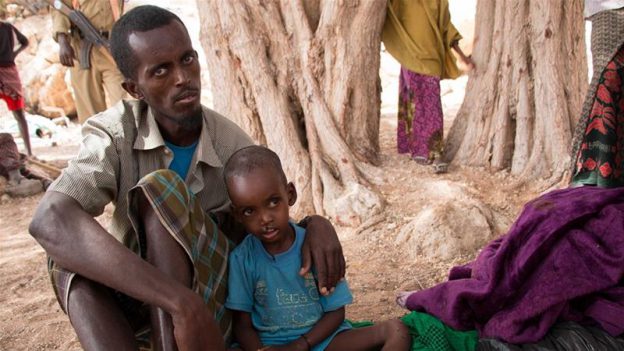Puntland, Somalia – Ahmed Osman, 34, gathered his tiny son into his arms and walked for three hours to reach the nearest medical centre in Dhudo village in Puntland, a semi-autonomous region of Somalia.
His three-year-old son, Mohamed, was desperately frail. He had been suffering from fever, vomiting and acute diarrhoea for eight days.
“My wife and three other children are behind in our camp with the surviving goats. I am the only one who could carry the baby all this way,” he told Al Jazeera.
The clinic in Dhudo is a small local government facility supported by aid group Save the Children. Nurse Bahija Abdullahi says she has been receiving two to three children a day since January. They are coming from makeshift pastoralist settlements scattered across the area, she explains.
The diarrhoea and fever has taken a toll on Mohamed’s health. Abdullahi can offer him oral rehydration salts and sachets of high-calorie peanut paste, but she doesn’t have the resources to treat cases of critical malnutrition like his.
Such children can be referred only to three hospitals in all of Puntland – Garowe, Bosaso and Galkayo – each hundreds of kilometres apart.
Osman is a nomadic pastoralist whose family has raised sheep, goats and camel in the arid Nugaal district in southern Puntland for generations.
Erratic rainfall
However, more than two years of protracted drought and erratic rainfall have killed off most of his animals, separated his family and driven him further from his native place than he has ever needed to travel.
Swaths of Somalia are once again on the edge of famine. On Sunday, Prime Minister Hassan Ali Khaire announced the deaths from starvation of 110 people in 48 hours in the country’s south-west.
It is six years since Somalia’s last famine killed some 260,000 people.
Now, nearly 6.2 million people – more than half the population – face acute food and water shortages and almost three million are going hungry.
“In my whole life in Somalia I have never seen so many dead livestock,” says Mowlid Mudan, communications officer for Save the Children, one of the few organisations working in Puntland.
READ MORE: Antonio Guterres raises alarm as hunger crisis worsens
“Sixty percent of our population relies on livestock to live and the rest are somehow connected. These families have lost every single animal. Even their camels. When the camels start to die you know that people will be next.”
Osman is not the only one who has headed for Dhudo. The village is built around the only substantial water source within a 75km radius: currently a diminishing green rivulet which pools in a rocky gully.
Bandar Bayla, the eastern district alongside the Indian Ocean where Dhudo lies, saw fleeting showers in late 2016.
Word spread and pastoralists travelled from as far as neighbouring Ethiopia in search of pasture for their herds.
But there has been no more rain.
Somalia is only fed by two perennial rivers – the Juba and the Shabelle – neither of which enter Puntland.
Carcasses litter the landscape; small heaps of bones, shrivelled skin and fur. Countless sheep and goats huddle together in the sand and die where they lay.
Abdirisak Farah, 40, brought his herd 200km from Nugaal to Bandar Bayla. Of his 500 animals, fewer than 100 survive.
“We had to leave our wives and children behind in villages because they are not strong enough to make this journey on foot,” says Farah.
“I have never had to move so far to find pasture.”
State of disaster
Some 250km further inland, ragged displacement camps are expanding on the fringes of towns as destitute nomads are forced out of the wilderness to seek assistance.
Shaxade, off the main road between the hubs of Garowe and Qardho, is currently home to dozens of women and children whose adult male relatives left for the coast with their herds two months ago.
“We are here because we have lost almost everything. We were feeding cardboard and water to our animals,” says Star Abdullahi, a mother of six.
“We are depending on the host community for food and the clinic nearby for the weakest ones. Our situation is bad but at least we are a group of women protecting each other. In the bush we were scattered and alone. This is safer for us.”
READ MORE: Famine stalks Somalia again
Somalia elected a new president in February following a drawn-out political process.
Ten days into his term, President Abdullahi Mohamed Farmajo declared a drought-induced state of disaster across the country, and a national drought response team was established.
Puntland is a territory that identifies as semi-autonomous – unlike breakaway Somaliland in the far north – and wishes to remain part of a federal Somalia.
Access for humanitarian aid across much of South Central Somalia remains impossible because the country is still fighting the armed group al-Shabab.
Puntland, where drought has also ravaged the countryside, however, considers itself more stable. Local leaders say they have been sounding the alarm for more than a year to little effect.
“We are in a pre-famine situation and the time to act is now,” says regional Environment Minister Ali Abdullahi Warsame at his office in Garowe.
“We are already reporting deaths by hunger and because people are drinking contaminated water … The entire economy is collapsing … But 95 percent of Puntland is accessible, unlike the south. Our government has meagre resources but is ready to assist the NGOs, but all eyes are on Mogadishu [Somalia’s capital] and the political transition.”
International support
According to Warsame, Puntland’s government raised more than $1m for drought relief in November, with large contributions from the diaspora and local door-to-door collections.
“We only need very basic food, sanitation and shelter items but we need them urgently in the next three weeks … The bulk of our response has been community-led. The international support is a drop in the ocean. It never comes at the right time,” he said.
At of the start of the year, international NGOs and the UN requested some $825m from donors during the first half of 2017 to prevent famine in Somalia.
IN PICTURES: Drought in Somalia – Time is Running Out
Funds are coming in at a faster rate than in 2011 and humanitarian agencies now have a stronger presence on the ground, according to Julien Navier, spokesperson for the UN’s refugee agency.
Nevertheless, competing catastrophes in South Sudan, Yemen and the Lake Chad basin mean that what is desperately needed to halt an avoidable tragedy may not materialise in time.
Sahara Mohamed has brought her three children to a small clinic in Yaka village, close to the Shaxade displacement site. Her husband took their surviving goats to the coast two months ago.
She cradles her two-year-old, who is barely conscious, while her three-year-old lies limp on the cot beside her. Her oldest son sits shivering on the edge of the cot, an intravenous (IV) tube inserted under the skin of his small hand. Nurses believe he is suffering from pneumonia.
“Children are getting sick because they are weak but they don’t have to be,” says Mudan. “You can see this is preventable if we move fast.”
Source: Al Jazeera News








